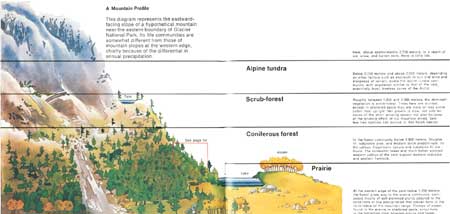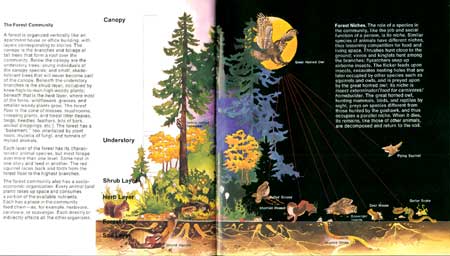
A Mountain Profile
This diagram represents the eastward-facing slope of a hypothetical
mountain near the eastern boundary of Glacier National Park. Its life
communities are somewhat different from those of mountain slopes at the
western edge, chiefly because of annual precipitation.
Here, above approximately 2,750 meters, in a realm of ice, snow, and
barren rock, there is little life.
Alpine Tundra Below 2,750 meters and above 2,000 meters,
depending on other factors such as exposure to sun and wind and
steepness of terrain, exists the alpine tundra community, with
vegetation similar to that of the vast, essentially level, treeless
zones of the Arctic.
Scrub-forest Roughly between 1,800 and 2,000 meters, the dominant
vegetation is scrub-forest. Trees here are stunted: except in sheltered
spots they are more or less prone rather than upright. Net growth is
slow, not only because of the short growing season but also because of
the pruning effect of icy mountain winds. Very few tree species can
survive in this harsh habitat.
Coniferous forest In the forest community below 1,800 meters,
Douglas fir, lodgepole pine, and western larch predominate, in the
valleys. Engelmann spruce and subalpine fir are found. The somewhat
lower and much better watered western valleys of the park support
western redcedar and western hemlock.
Prairie At the eastern edge of the park below 1,200 meters, the
forest gives way to the prairie community, composed mostly of
soft-stemmed plants adapted to the conditions of low precipitation that
prevail here in the rainshadow of the mountain range. Clumps of aspen,
found in the prairie in sheltered spots, occur here in the transition
zone between prairie and forest.
(click on above image for an enlargement in a new window)
|

The Forest Community
A forest is organized vertically like an apartment house or office
building, with layers corresponding to stories. The canopy is the
branches and foliage of tall trees that form a roof over the community.
Below the canopy are the understory trees: young individuals of
the canopy species; and small, shade-tolerant trees that will never
become part of the canopy. Beneath the understory branches is the
shrub layer, occupied by knee-high-to-man-high woody plants;
beneath that is the herb layer, where most of the ferns,
wildflowers, grasses, and smaller woody plants grow. The forest
floor is the zone of mosses, mushrooms, creeping plants, and forest
litter (leaves, twigs, needles, feathers, bits of bark, animal
droppings, etc.). The forest has a "basement," too, interlaced by plant
roots, mycelia of fungi, and tunnels of myriad animals.
Each layer of the forest has its characteristic animal species, but most
forage over more than one level. Some nest in one story and feed in
another. The red squirrel races back and forth from the forest floor to
the highest branches.
The forest community also has a socioeconomic organization. Every animal
(and plant) takes up space and consumes a portion of the available
nutrients. Each has a place in the community food chain—as, for
example, herbivore, carnivore, or scavenger. Each directly
or indirectly affects all the other organisms.
Forest Niches. The role of a species in the community, like the
job and social function of a person, is its niche. Similar
species of animals have different niches, thus lessening competition for
food and living space. Thrushes hunt close to the ground: vireos and
kinglets hunt among the branches; flycatchers snap up airborne insects.
The flicker feeds upon insects, excavates nesting holes that are later
occupied by other species such as squirrels and owls, and is preyed upon
by the great horned owl; its niche is insect exterminator/food for
carnivores/homebuilder. The great horned owl, hunting mammals,
birds and reptiles by night, preys on species different from those
hunted by the goshawk, and thus occupies a parallel niche. When it
dies, it remains, like those of other animals, are decomposed and return
to the soil.
(click on image for an enlargement in a new window)
|

|

|
|


